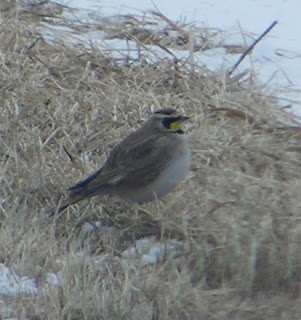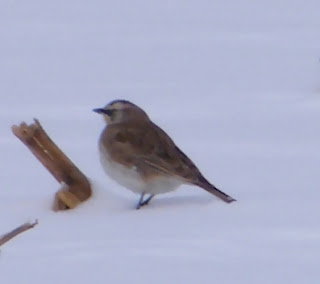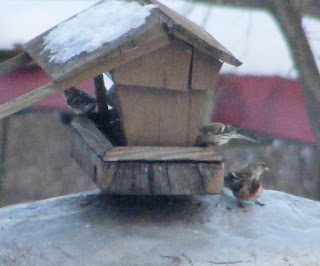I recently posted the following to MNbird (the MN bird listserve). The original question was about how to learn to ID birds.
Enjoy.
-----------------
Jim, Sharon and all,
You can't learn all the birds from one source. Some birds you learn
from your field guide, some from workshops, some from being out in the
field, some from experts. The information is out there in many forms.
The work you have to do is piece it all together.
There is a lot of memorization and retension involved.
One thing I think all birders should learn is ID by GISS. General
impression of size and shape can help immensly. One thing you can
study is silhouettes. How does the bird look to you? is it big? small?
thin? bulky? chunky? Does it have a long tail or short?
9 out of 10 times though, you're IDing by GISS when the bird is in
flight. so you have to ask, how long are the wings? are they thin? are
they pointed? or are the short rounded and broad? How fast are the
wingbeats? are they regular? Does the bird fly in a straight line or
does it fly in a wave pattern like a Goldfinch?
These are just some of the questions that go through my head when I
see a bird and attemp to ID it. All I can say is Practice practice
practice. Spend as much time in the field as possible. It's the only
way to really get to know the birds.
Above all, Do NOT try to ID the bird in the field by field marks
alone. There are many many factors involved in ID just from the
bird's suroundings that can make your final ID much easier. Many
times, you will not see enough of the bird to ID from just it's field
marks. Learn to recognize which birds live in certain habitats. that
will help a lot in knowing which birds to expect there.
Sight ID just has to be memorization. Not just retension of what you
think a bird looks like, it has to be memorized to a point that you
know without thinking.
If you want to learn Warblers, I highly reccomend getting the Peterson
field guide to Warblers. It has a plate which shows all the undertail
patterns. Each pattern is slightly different. No two are exactly
identical. 9 out of ten times, that's all you see anyway. just the
tail. Anyway, I could go on forever about ID by sight but I have
other things to touch on.
ID by sound. I suggest that instead of trying to just plain memorize
all the different calls and songs, look at learning to ID by sound the
same as learning a new language. That's all it is anyway. It's
practically the same thing. Be able to hear the subtle differences
between an Ovenbird and a Kentucky Warbler at long range. Be able to
note that the Ovenbird is more warbly than the Warbler. Listen to CD
recordings and pay attention out in the field. One of the best ways to
learn new bird songs, is to track down the bird that's singing. If it
is possible, when you hear a bird that you don't know, track it down.
The song will register much better that way than if you had just heard
the song on a CD.
Now, let me give you an example of IDing by sight and sight alone and
field marks alone. Shorebirds. Here's what you need to do for
Shorebirds. First off, divide the birds into groups. Your first group
should be birds like Turnstones, Dunlin, Willet, Avocets, Godwits,
Solitary Sandpiper, ect. birds that you know are easy for you to ID.
The second group is birds that are a little harder. Pectoral
Sandpiper, Purple Sandpiper, ect. birds that a harder than the first
group but are still IDable about half the time.
Your third group should be all Peeps. Least, SemiP, Baird's
sandpipers, ect. Birds that are either hard or just plain unIDable to
you. now, take your third group and divide them up the same way. then
figure out which birds stand out above the crowd. birds that are built
differently or have longer bills or legs or are colored differently.
If you do this, and keep dividing them, you will learn to recognize
almost all of the different shorebird species. Each one is different
in some way. It's up to you to find the differences.
Now, the final step in ID,
take everything that you learn and put it together.
Now, you have a bird to ID. Use the process of ELIMINATION. The bird
is small? warbler or sparrow sized? immediately rule out crows,
hawks, gulls, herons, ect. all the large birds. In one of his books
on birding, Pete Dunne tell a story about the importance of size in
ID. It goes something like this:
"There was one instance in england that I recall, a woman had called
the local bird organization to ask a question about a bird she was
seeing in her yard. The local bird expert answered and asked her to
decribe the bird. So she gave the field marks and noted especially
that the bird had a Red face. The man suggested that she had a
Goldfinch (European Goldfinches have a red face). She replied that she
did not think the bird was a Goldfinch. So he asked her to describe
the bird again. Again, he concluded that the bird was a Goldfinch. She
insisted that the bird was NOT a Goldfinch.
Intrigued, he decided to visit and see for himself. When he arrived,
he found to his amazement, a 4 foot tall Sarus Crane standing in her
yard.
He said later, 'She had forgotten to mention the bird's size'."
So there you go, size matters. After that, then look at the bird's
general field marks. Is it a Sparrow? a warbler? a Wren? What is the
habitat around it? is it marsh? field? woodland? you get the idea.
Anyway, go through and rule out the possibilities one by one.
eventually, you will end up with only one possiblity.
If you rule out ALL the possibilities, start over and see if there's
anything you might have missed. Do this twice. If that doesn't work,
then go to the experts. If that doesn't work, go to the big experts
(people like Pete Dunne and Kenn Kaufman and David Sibely). And if
that doesn't work? Start thinking about what you're going to name
this bird.
Everyone sees birds differently and everyone has a set way that works for them.
These are just some of the methods that I use regularly.
Happy Birding! --Chris W, Richland County WI
http://swallowtailedkite.blogspot.com
http://web.mac.com/stoneageoutpost/RC_Birding/RC_Birds.html



























































